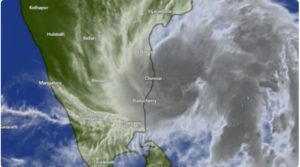Physical Address
23,24,25 & 26, 2nd Floor, Software Technology Park India, Opp: Garware Stadium,MIDC, Chikalthana, Aurangabad, Maharashtra – 431001 India
Physical Address
23,24,25 & 26, 2nd Floor, Software Technology Park India, Opp: Garware Stadium,MIDC, Chikalthana, Aurangabad, Maharashtra – 431001 India

In late November 2024, Cyclone Fengal impacted Sri Lanka, leaving a significant trail of destruction. Originating in the Bay of Bengal, the storm brought heavy rainfall, powerful winds, and devastating floods to several provinces, including the Eastern, North Central, Northern, and Northeastern regions. The calamity has affected over 441,000 individuals and prompted immediate emergency responses from local authorities and humanitarian organizations.
Path of the Cyclone and Its Effects
Cyclone Fengal began impacting Sri Lanka on November 23, 2024, with relentless rain inundating the eastern coastal areas. By November 26, the situation had escalated, with flash floods damaging homes, infrastructure, and farmland. The storm intensified two days later, bringing winds exceeding 60 km/h and prompting the opening of reservoir spill gates, which aggravated flooding in downstream areas. The regions worst hit included districts in the Eastern and Northern provinces, such as Ampara, Batticaloa, and Jaffna.
The storm also disrupted transportation networks, with roads and bridges either submerged or damaged. Authorities closed key routes, such as the Colombo-Ratnapura-Batticaloa highway, redirecting travelers to alternative paths. Landslides in hilly areas like Moragolla further compounded access issues, isolating some communities entirely.
Humanitarian Impact and Response
With over 37,000 people displaced to temporary shelters and another 50,000 staying with relatives, the immediate need for assistance became clear. Reports indicated that nearly 100 homes were completely destroyed, and over 2,000 suffered partial damage. Livelihoods were severely impacted, particularly in agricultural areas where an estimated 390,000 acres of crops were submerged.
Organizations like the Sri Lanka Red Cross Society (SLRCS) rapidly mobilized resources to address the crisis. Volunteers distributed essential household items, such as tarpaulins and drinking water, and launched community cleanup campaigns. Emergency first aid teams provided medical care to affected individuals, while health authorities issued warnings about waterborne diseases like dengue and leptospirosis, which are likely to rise as floodwaters recede.
Addressing Immediate Needs
Key relief efforts have focused on shelter, food, and health services. In Ampara, Batticaloa, and Jaffna, where damage was most extensive, displaced families received hygiene kits, cooked meals, and basic supplies. Farmers were also provided with fertilizer and tools to recover their damaged fields, while the government and aid agencies worked to restore access to safe drinking water and sanitation facilities.
Additionally, educational support is being offered to children who lost school supplies in the floods. With over 1,400 school packs distributed in the hardest-hit areas, efforts are underway to help students return to their studies.
Coordinated Relief and Lessons Learned
The disaster response has been a collaborative effort between local government bodies, the military, and international organizations. Lessons from previous disasters were applied to enhance coordination, ensuring timely distribution of aid and avoiding duplication of efforts.
As the country begins to recover, the focus remains on rebuilding lives and mitigating future risks. The resilience of affected communities, coupled with the swift response of volunteers and authorities, underscores the collective determination to overcome the challenges posed by Cyclone Fengal.
Source: ReliefWeb
DMC Sri Lanka – Situation Report